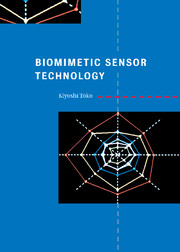6 - Taste sensors
Published online by Cambridge University Press: 23 October 2009
Summary
A multichannel taste sensor, i.e., electronic tongue, with global selectivity is composed of several types of lipid/polymer membrane for transforming information of taste substances into electric signals, which are input to a computer. The sensor output shows different patterns for chemical substances that have different taste qualities such as saltiness and bitterness, while it shows similar patterns for chemical substances with similar tastes. The sensor responds to the taste itself, as indicated by the fact that taste interactions such as the suppression effect, which occurs between sweet and bitter substances, can be reproduced well. Amino acids can be classified into several groups according to their own tastes based on sensor outputs. The mixed taste elicited by amino acids such as l-valine and l-methionine, which implies that the taste comprises two or three taste qualities such as sweetness and bitterness, is expressed quantitatively by a combination of the basic taste qualities elicited by l-alanine and l-tryptophan. The taste of foodstuffs such as beer, coffee, mineral water, milk, sake, rice, soybean paste and vegetables can be discussed quantitatively using the taste sensor, which provides the objective scale for the human sensory expression. Miniaturization of the taste sensor using FET gives a sensor with the same characteristics as the above taste sensor by measuring the gate-source voltage. The taste sensor can also be applied to measurements of water pollution. It will open doors to a new era of food and environmental sciences.
- Type
- Chapter
- Information
- Biomimetic Sensor Technology , pp. 113 - 180Publisher: Cambridge University PressPrint publication year: 2000
- 12
- Cited by



